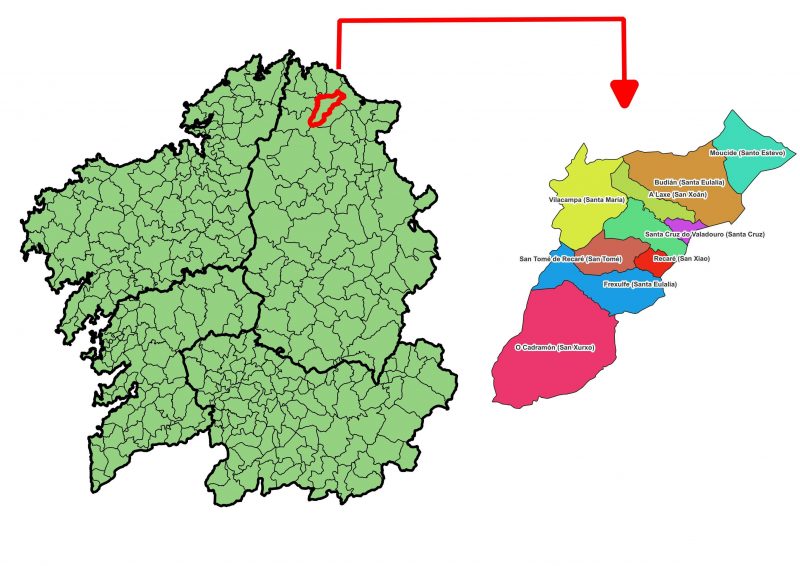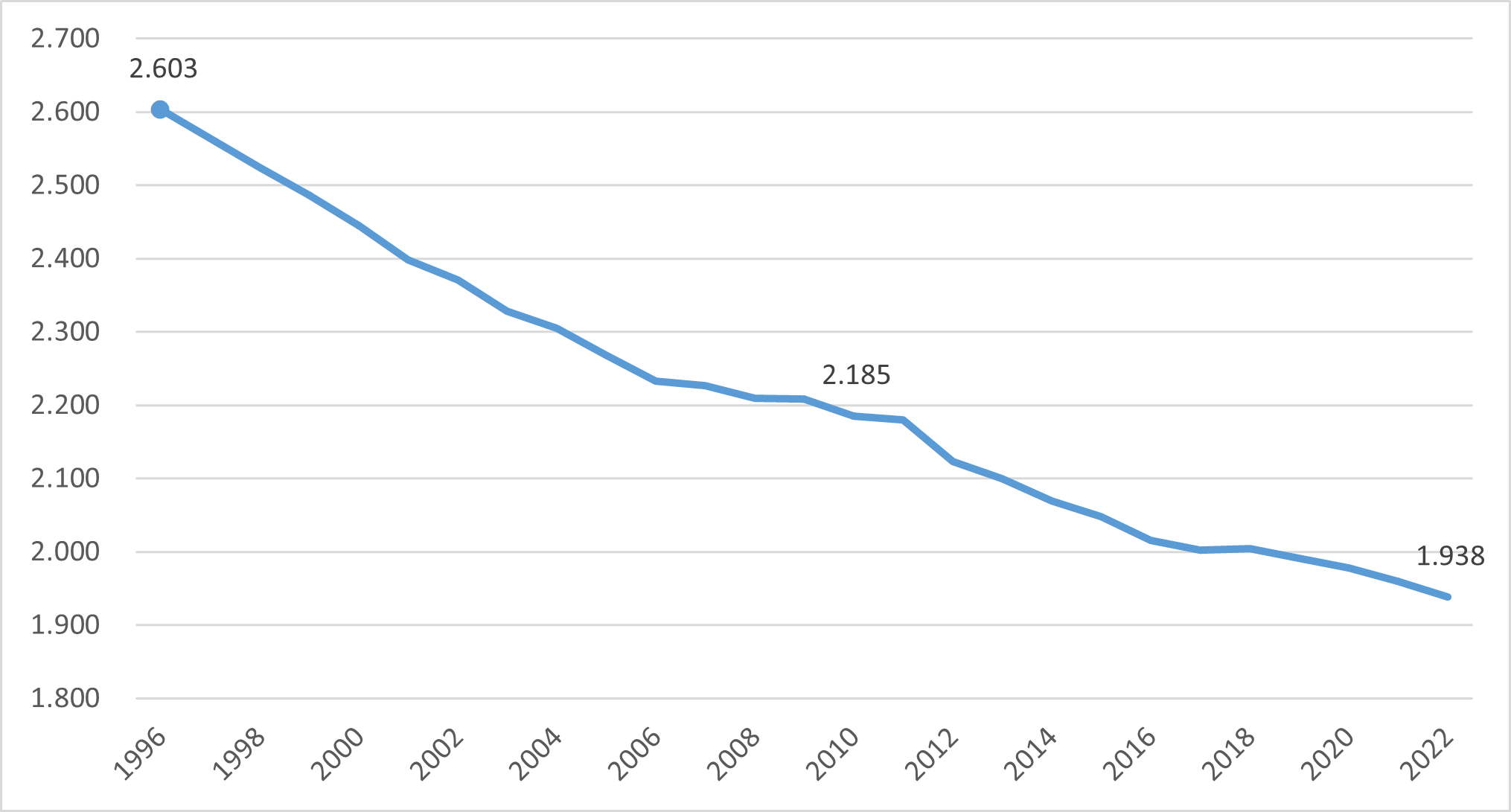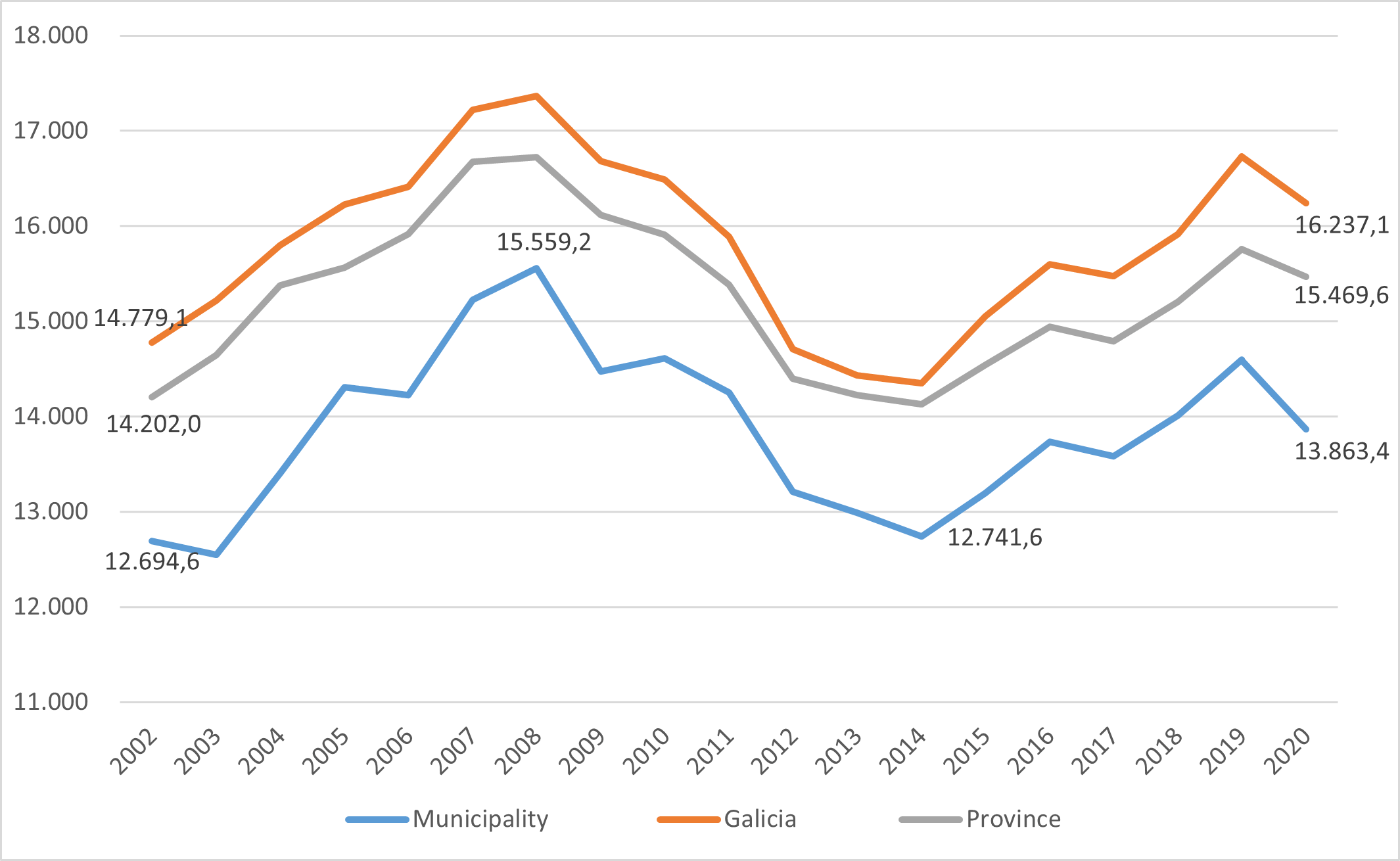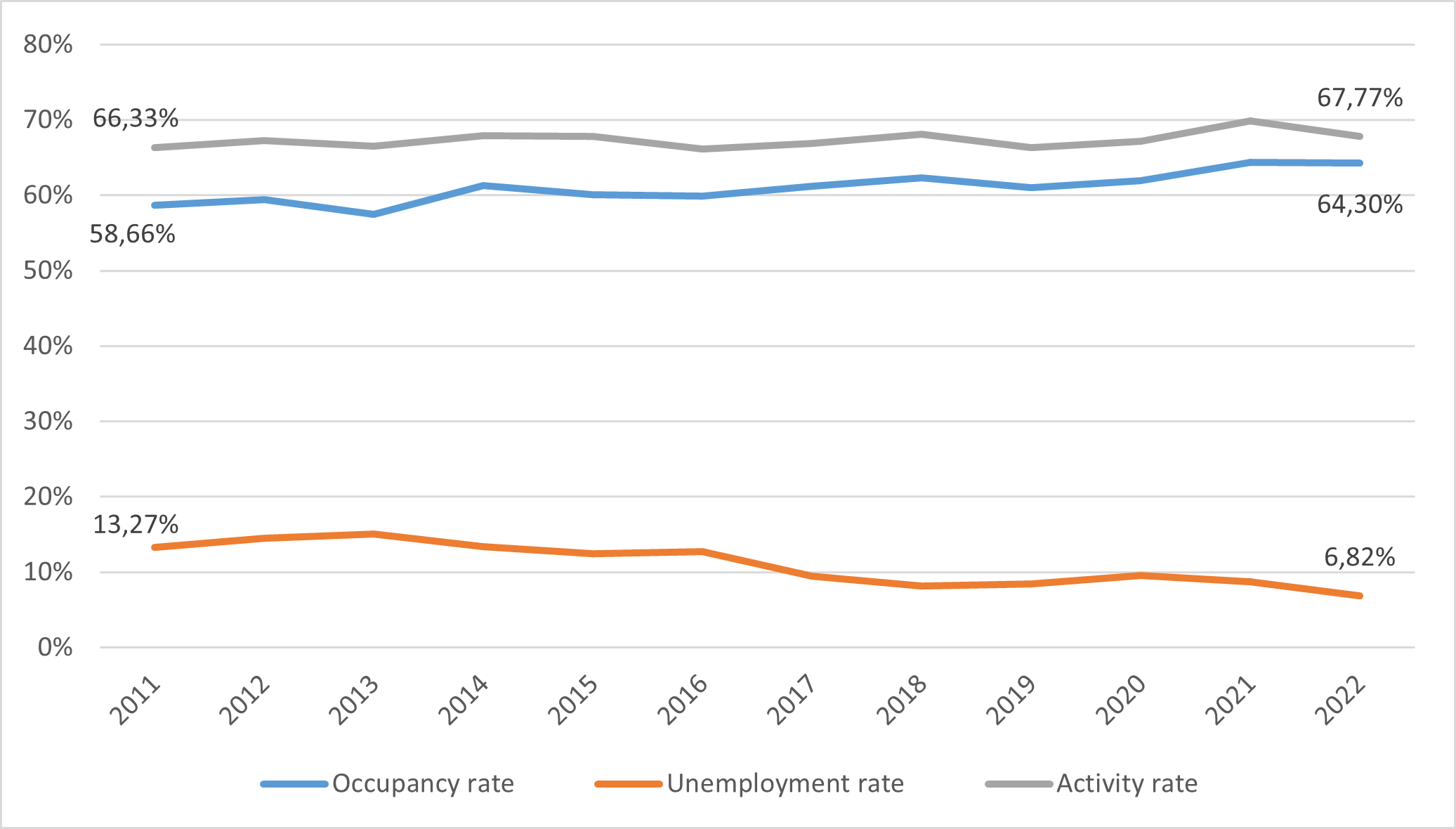
Introduction
The Municipality of O Valadouro is located in the region of Mariña Central, northwest of the province of Lugo and 84 kilometres from the provincial capital, is a territory of 1,938 inhabitants in 2022 that has an area of 110.45 square kilometres, presenting a title of urbanization of sparsely populated area, according to the Galician Institute of Statistics.
It is part of Terras de Miranda Rural Development Group (RDG1).

Population and demographic structure
The population of O Valadouro showed a continuous loss of inhabitants from 1991 to 2022, with a decrease of 877 inhabitants, representing a reduction of almost 31%. This decline far exceeded the 1.5% decline recorded in Galicia and the 15.7% decline observed in the province of Lugo over the same period. However, in the last decade, from 2012 to 2022, the population reduction was less pronounced in Valadouro, with -8.7%, and in Lugo, with -7%, but more pronounced in Galicia, with -3.3%.
The demographic analysis of O Valadouro also revealed a change in the age distribution, with a progressive ageing of the population. Although there was a large loss of working-age population, in recent years there has been an increase in the young population. During the period from 2002 to 2022, the age group most affected by population loss was the adult population, aged 16-64, which experienced a reduction of 27%, equivalent to 380 fewer people of working age. The population aged 64 and over also experienced a reduction of 8%, corresponding to 56 fewer people. Over the last decade, both age groups showed a slowdown in population loss, with the adult population decreasing by 15%, while the population over 64 has decreased by 6.5%. The young population showed a slight growth throughout the whole period, especially significant in the last decade. Thus, the population under 16 years of age increased by 30% between 2012 and 2022, which represents 49 more people in the municipality, a positive sign for its development.
Despite this, demographic ageing is reflected in the population pyramid, with a narrowing of the base and a thickening of the top. In addition, the average age in the municipality was expected to rise to 52 by 2022, close to 54 for women and slightly above 50 for men.
The General Dependency Ratio (GDR) in O Valadouro peaked in 2022 at 86%. This increase was mainly due to the reduction in the working age population and the increase in the number of young people in the dependent population group. After reaching its lowest point in 2006, the index experienced a continuous growth until 2022, notably different from the index at both Galician and provincial level.

Population dynamics in O Valadouro.

Evolution of the total dependency ratio of O Valadouro, Lugo and Galicia.
Economy
The evolution of Gross Disposable Product (GDP) with its growth rates in the municipality changed direction every two years in the decade from 2010 to 2020. By contrast, the growth rates of the territorial groups remained mostly in positive territory, except for a first period of decline between 2010 and 2012.
Between 2018 and 2020, GDP contracted at all three territorial levels, with a decline of 13% in O Valadouro, in line with the reductions observed in Galicia, with -7.7%, and in Lugo, with -7.2%. Subsequently, Galicia showed a recovery of total GDP with a growth of 10.5% until 2021. In 2022, the municipal GDP ended up reaching a value of around 32.37 million euros.
The Gross Disposable Income (GDI) showed from 2002 to 2020 periods of remarkable growth, especially between 2003 and 2008, with an increase of 24%, which is above 15,500 euros. Subsequently, it showed a downward trend, in line with the territorial groupings, until 2014. It changes course and grows until the outbreak of the pandemic, which causes a contraction at the municipal, provincial, and regional levels. In 2020, gross disposable income per inhabitant stands at 13,863 euros, after a fall of -5% due to the negative effects of the pandemic, similar to the falls of -3% and -1.8% in Galicia and Lugo, respectively. At a global level, it shows an increase of 9% in the period analysed (2002-2020), at the same level as the income of Galicia as a whole, with 9.8%, and of the province of Lugo as a whole, with 9%.
Using the register of social security affiliations as an estimate of municipal employment, between 2011 and 2022, O Valadouro registers a negative trend with a reduction of -10%, in contrast to the growth registered in Galicia, with 8% and a constant level in Lugo. level. In the primary sector the number of affiliations fell by -31%. In the secondary sector it fell by 30%. In the tertiary sector it increased by 7.8%.
Despite this, the primary sector in O Valadouro has a relatively high proportion of the total number of affiliations, collecting around 11%, a slightly lower proportion than in the province of Lugo, while in Galicia it only collects 5%. The secondary sector registers around 20% of the affiliations in the three territorial levels, being slightly above, with 23%, the proportion of the municipality. Finally, the tertiary sector is the main productive sector in terms of affiliations, representing approximately 66% in O Valadouro and more than 70% of affiliations in the territorial groups.
In 2022, O Valadouro had an activity rate of 68%. The employment rate was 68%, which is a notable difference of fifteen percentage points compared to the average for Galicia and Lugo. The unemployment rate showed a gradual decrease from 13.3% in 2014 to 6.8% in 2022, placing it below the rates of the territorial groups.

Evolution of Gross Disposable Income per inhabitant in O Valadouro, Lugo and Galicia.

Evolution of employment, unemployment, and activity rates in the municipality of O valadouro.
Energy resources
O Valadouro has a large supply of energy from renewable sources, specifically wind power. With a total of 99 wind turbines in 2022 and an installed capacity of 106.78 MW, O Valadouro achieves an estimated annual production of between 185,975.8 and 264,913.2 MW. However, diversification of renewable energy sources is essential to strengthen the energy resilience of the municipality and maximise its economic potential. The expansion of other forms of renewable energy, such as solar, hydro or biomass, would not only help to reduce dependence on a single source, but could also generate new economic and employment opportunities in the area.
The electricity consumption of O Valadouro in 2023 was 4,528.78 MWh. Residential consumption was 2,885.14 MWh. The consumption of services, including municipal services, was 1,384.77 MWh. Industry consumed 258.86 MWh.
Energy Policy Councils
Date of the first meeting:
4th April 2024
Number of participants:
30 people
Profile of participants:
- Staff of the municipality of O Valadouro: councillor for Environment
- EC4RURAL project staff: UVIGO, ESPAZOCOOP, FEGAMP
- Citizens
Evaluation of the energy situation
O Valadouro has a wide range of renewable energy sources, especially wind energy, with a total of 99 wind turbines and an installed capacity of 106.78 MWh. Annual production is estimated at between 185,975.8 and 264,913.2 MW.
O Valadouro intends to develop an energy community in the short term, and to try to cover the whole municipality in the long term.
There have been previous meetings on the subject, during which a great deal of interest in the subject was noted, but nothing concrete was done.
Dialogue between the parties
During the meeting, an open dialogue was held between citizens and the municipality on the production of photovoltaic energy. There was interest in the spatial-territorial distribution of photovoltaic panels, with reference to the problems that could arise from the problems that may exist due to heritage protections. The need to move towards hybrid energy models that allow the full autonomy of rural communities through the diversification of renewable sources was highlighted. There were several interventions on the possibility of registering and deregistering an energy community, as well as other concerns at a more advanced stage of the process, such as the administrative procedures for registering photovoltaic installations.
Conclusions
After the joint co-creative process, the first contact with the neighbourhood and local authorities have been positive. There is a real interest in the development of the rural energy community as they think about joint action and the benefits of making it happen.
As a final conclusion of this meeting, the Energy Policy Council has been created.



